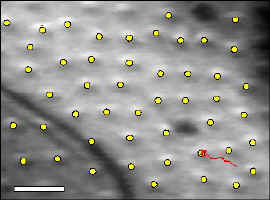A Peek at the Superconducting “Pinscape”
While some superconductors exclude magnetic flux entirely, many support a “Swiss cheese” condition, where an applied magnetic field penetrates only as an array of thin tubes known as vortices. Five years ago, a Japanese group first imaged the motions of these nanometer-scale structures. Now their American collaborators (led by David Grier, of the University of Chicago) have used the movies to directly measure the interaction energies of vortices and the “landscape” of crystal lattice defects that influence their motion. Understanding this landscape is critical for making superconducting wires, but its properties have previously been difficult to measure.
Previous vortex studies could not resolve individual vortices or produced only static pictures, but in 1993 Akira Tonomura and his colleagues at Hitachi, Ltd., in Hatoyama, Japan, made vortex movies with unprecedented resolution, using a type of transmission electron microscope. In some of the movies, a slight spatial gradient in the applied magnetic field causes the vortices to drift slowly in one direction, but the drift is superimposed on a random walk, as the vortices jump from one crystal lattice defect, or “pinning site,” to another. Vortices are attracted to these sites because defects disrupt the superconductivity somewhat. Since the slender core of each vortex is driven non-superconducting by the magnetic field, the vortex requires less energy to exist where the superconductivity is already partially compromised. With the weak pinning of Tonomura’s movies, vortices typically escape within a second.
The drunken walk of vortices through their “pinscape,” as it’s sometimes called, reminded Grier of his work with colloids, where particles suspended in a liquid undergo Brownian motion. He realized that the characteristic energy of the pinscape–the depth of the energy well for a typical pinning site–plays essentially the same role in the vortex “liquid” as the thermal energy * kT* plays in a conventional liquid. “That was a thunderbolt,” he recalls. In a perfect crystal with a flat pinscape, inter-vortex repulsion would lead to a two-dimensional triangular vortex lattice, but with pinning wells deep enough, the vortex arrangement becomes disordered. Grier likens the situation to the melting of a solid when kT becomes comparable to the energy of inter-molecular attraction–only in the case of vortices, it is the energy depth of pinning sites that is compared with the inter-vortex repulsion energy.
In the videos a river of pimple-like protrusions flows persistently along a surface, but each one starts and stops as it encounters defects, continuously nudged by the inhomogeneous magnetic field. Grier and his colleagues used methods of movie analysis they developed for studying colloid particles. From the 30 frames-per-second movies of vortex motion in niobium they found time-averaged positions of the vortices and mapped out the pinscape–the positions and energy depths of the pinning sites in the field of view. This led to a distribution of pinning energies which closely resembles an exponential, Boltzmann-like form, with the characteristic pinning site depth taking the place of kT. Using vortex-vortex position correlations, time-averaged over almost 1000 frames, the team derived the vortex interaction potential function and found it agreed with theoretical predictions for this relatively simple system. Grier believes the new combination of imaging and statistical analyses will allow “a whole new way of looking at the problem” of vortex motion in many other systems.
Martin Maley, of Los Alamos National Lab, is impressed with the results. He says the new techniques could provide a “powerful way of getting new information” about vortex dynamics and the pinscape. Since a moving vortex creates a voltage drop, it destroys the resistanceless current flow of a superconductor. Pinning the “vortex liquid” remains the greatest challenge to engineering high-temperature (high Tc) superconducting wires, according to Maley, and the new techniques should help in that effort. The new field of “vortex matter” should also benefit: A rich variety of phenomena are observed in high- vortices, such as melting, elastic and plastic deformations, and even a type of viscosity, and the growing community of researchers in this field is eager for more experimental tools.



